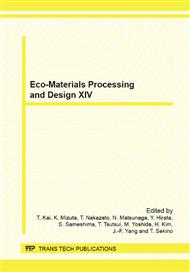p.121
p.125
p.131
p.135
p.141
p.147
p.151
p.157
p.161
Characterization and Cell Response of Novel Hydroxyapatite/Glyceride-Based Polyurethane Porous Scaffold
Abstract:
The glycerides of castor oil (GCO) were copolymerized with isophorone diisocyanate (IPDI) to generate glyceride-based polyurethane (GCPU), meanwile blending with hydroxyapatite (HA) powder to fabricate porous composite scaffolds. The effect of HA content on mechanical properties of the resulting polymer scaffolds and the in vitro cell response of HA/GCPU scaffolds were investigated, by use of mechanical testing, FTIR, SEM and MTT assay. The results showed that the compressive strength increased with HA content, and the HA/GCPU scaffold with 40 wt% HA reached about 4.6 MPa, much higher than the scaffold without HA (only 605 kPa). The SEM observation, live-dead staining assay and MTT assay demonstrated the excellent biological properties of HA/GCPU scaffolds, which support cell adhesion and proliferation. This novel class of HA/GCPU porous scaffolds have prospect and advantage for bone repair and regeneration.
Info:
Periodical:
Pages:
141-144
Citation:
Online since:
July 2013
Authors:
Keywords:
Price:
Сopyright:
© 2013 Trans Tech Publications Ltd. All Rights Reserved
Share:
Citation:


